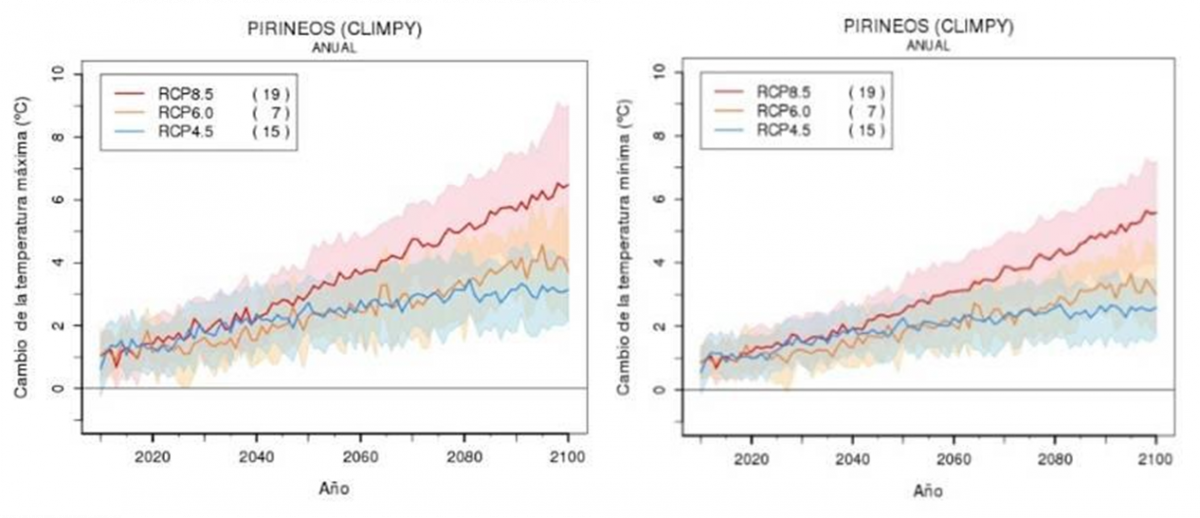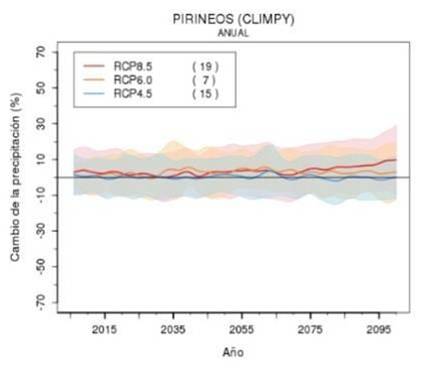Future climate projections
Despite the uncertainties relating to future socio-economic scenarios and the limitations of the numerical models used for climate projections, the main climate models agree that global warming will intensify over the coming decades, especially in mountain areas. This may mean an intensification of climate variability and of the trends already identified in the main climate variables. If these projections are confirmed, this could lead to major effects on the climactic, hydrological, environmental and landscape characteristics of the Pyrenean bioregion.
The preliminary results of climate projections in the context of the CLIMPY project (based on the data from a set of global climate models and combinations of regional climate models), considering the four global scenarios for emissions concentration RCP2.6, RCP4.5, RCP6.0, and RCP8.5 (RCP for “Representative Concentration Pathways”, where RCP2.6 is the most optimistic scenario and RCP8.5 is the most pessimistic), were used for a first probabilistic approach to predicting future climate, summarised below:
According to these projections, a significant rise in the daily maximum and minimum temperatures is expected throughout the 21st century, in the three emissions scenarios analysed (RCP4.5, RCP6.0 and RCP8.5) (Figure 4), in every season of the year across the entire Pyrenees area. This increase would be faster in RCP8.5, in relation to a more intense emissions scenario. The uncertainties associated with the RCP scenarios and global climate models increase over the century.

- For the 2030 horizon, the average annual change across the Pyrenean region in maximum temperatures compared to the reference period (1961-1990) could range from 1º C to 2.7º C for the RCP8.5. Similar or slightly lower increases were obtained for the minimum temperatures (0.9º C to 2.2º C for RCP8.5).
- For the 2050 horizon, warming would be somewhat higher. Increases in maximum temperatures would range from 2.0º C to 4.0º C for RCP8.5, and 1.4º C to 3.3º C for RCP4.5, while increases in minimum temperatures would range from 1.7º C to 3.3º C and from 1.2º C to 2.8º C respectively.
- For the end of the century, the ranges of values are even wider, the changes are even larger, and the separation between the scenarios associated with the different RCPs is clearer. With RCP8.5, the average maximum temperature change over a year would range from 4.3ºC to 7.1ºC, while for RCP4.5 it would range from 1.9ºC to 4.2ºC. For minimum temperatures, the corresponding intervals would range from 3.6 ºC to 6.0 ºC, in the first case, and 1.6 ºC and 3.5 ºC in the second.
Future precipitations are not predicted to change significantly over the 21st century, with little influence on their evolution, at least in terms of average values (Figure 2). The number of models showing average precipitation rising is similar to the number of models showing it decreasing. The uncertainties increase as we approach the end of the century, especially in the case of RCP8.5.

The first results on the evolution of average snow depth in the Pyrenees show a significant decrease despite a marked variability between years. In the Central Pyrenees, at an altitude of 1,800 m, average snow depth could fall by half by the 2050 horizon according to the current baseline, while the period of snow cover would have fallen by more than a month.
PYRENEAN CLIMATE CHANGE OBSERVATORY
Avenida Nuestra Señora de la Victoria, 8
22.700 - Jaca
Huesca - España
+34 974 36 31 00
info_opcc@ctp.org




